In the land of a thousand and one nights. Andalusian palace Alhambra and fairytale gardens!
Alhambra Palace in Granada is the most visited monument in Spain. The fortress enchants with its view and can boldly rival the monuments of Rome and Athens.
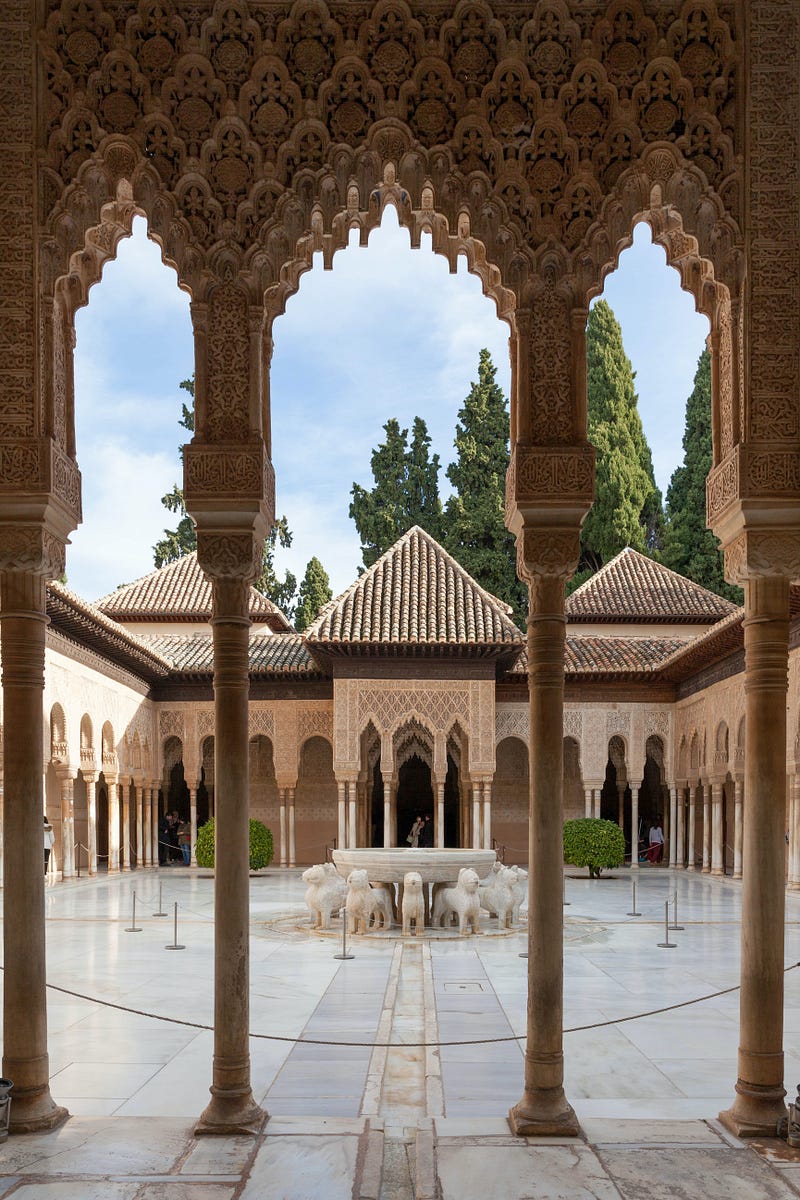
On a summer morning at dawn, Grenada is the best place to wake up. I am standing on the balcony of a white house in the Albayzin, the former Arab part of the city. The first rays of sunshine warm the crisp morning air, and before me stretches an extraordinary view. Hills covered by a tangle of streets, hundreds of blindingly white buildings. The whole, like commas in a text, is cut by spikes of cypress trees. The Alhambra, an Arab fortress, towers over the city.
The Alhambra Palace — a fairytale Moorish fortress
Your first stop in Granada should be the Alhambra. Despite the complicated entrance conditions (due to the popularity of this place, you need to either book in advance or show up before it opens), the Alhambra enchants with its view and can easily rival the historical buildings in Rome and Athens. Be prepared to spend most of the day at this site.
The emirs of Cordoba (a city northeast of Granada) built a fort, the Alcazaba, on this hilltop in the 11th century. Over the following centuries, Moorish rulers expanded the fortress until there were four palaces and summer gardens.
The 14th-century Casa Real is the heart of the entire complex illustrating the Moorish obsession with geometric architecture — often in the form of stars — and elaborate but subtle decoration. As you explore the magnificent Sala de los Abencerrajes and Salón de Embajadores, you’ll hear the sound of water in the background. If you look closely at the stucco and friezes, you will see an Arabic inscription proclaiming: “There is no conqueror before God”. The original Alcazaba, on the other hand, is a very simple structure and its towers offer a magnificent view of the city of Granada. It’s easy to see why the Moors chose this spot for a photo-op when they swept through Andalusia.
The Moors controlled Granada and its surroundings from the 8th to the 15th century, when the Catholics gradually conquered southern Spain. However, many cities in Andalusia, from Almeria in the east, to Seville, Cordoba, and Granada, retain characteristic buildings and neighborhoods built by the Moors.
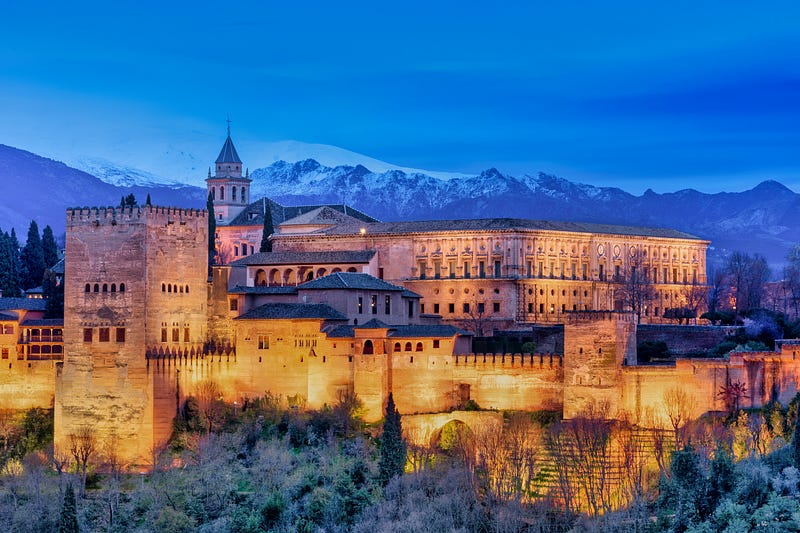
Alhambra Palace — How to plan a visit
Visiting Andalusia, it is not difficult to understand why for centuries the region has delighted visitors from all over the world. The most visited and spectacular site, however, is the Alhambra. The grandeur of the Nasrid Palace can be seen from the San Nicolás lookout point across the Darro River. The best time to go there is at sunset, when the accompaniment of guitars and the songs of local musicians echo through the area. Bill Clinton, President of the United States from 1993 to 2001, proclaimed it to be “the most beautiful sunset in the world.”
The name of the fortress comes from Arabic, in which the word الحمراء (alhamra’) means the color red. The structure was built between the 9th and 12th centuries and was planned as a military fortress.
Ultimately, the original Alhambra consisted of:
- The fortress
- Nasrid palace
- Medina (small town)
Since the whole complex is huge and full of worth seeing details, it is worth to plan some time to visit the Alhambra. Some tourists are able to walk around all parts of the building in two or three hours, but the real history buffs need at least half a day. And there is a lot to see: from the Alcazaba to the Royal Palaces, the charming Gilded Hall, the majestic Comares Hall, the Renaissance Palace of Charles V (now the Museum of Fine Arts) or the famous Courtyard of the Lions.
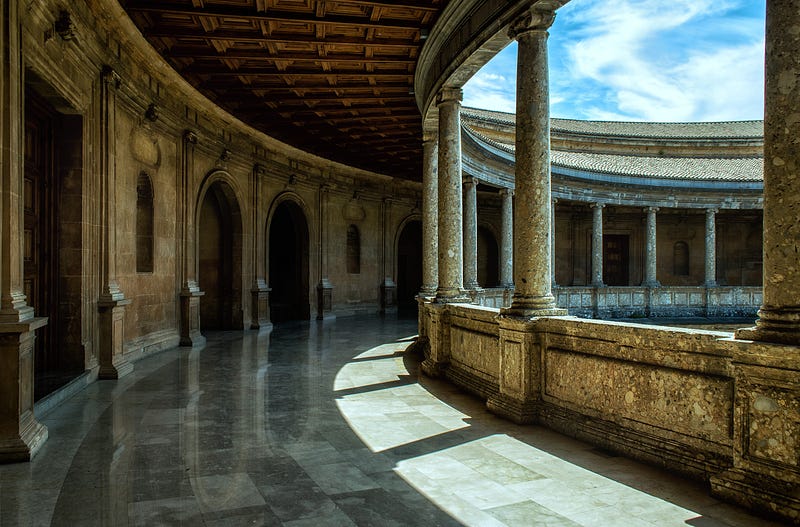
Where to start your tour?
- The best start with the magnificent gardens of the Generalife, the summer residence of the sultans. It is here where you can appreciate the artistry of Arab architects, who in an extremely harmonious way were able to combine plants and water. Unfortunately, the gardens have undergone numerous changes over the centuries and what you see today is somewhat different from the original Generalife design.
- Next, walk through the majestic Nasrid Palaces to the picturesque Courtyard of the Lions and the sound fountain located there, one of the most famous in the world. This fortress and residence of the emirs was built between 1238 and 1391 and consists of extremely beautiful halls with ornament-covered rooms. The Lions Courtyard was a private part of the palace, reserved for the sultan and his wives. Located inside, the patio with the famous fountain of 12 lions representing the next 12 months of the year was meant to represent the Muslim paradise.
- Finally, take a walk towards the Alcazaba, the oldest part of the Alhambra, dating back to the 11th century. Although it is the most modest part of the complex, it is worth going there to enjoy the fantastic view of Granada from the 27-meter high Torre de la Vela.
It owes its shape to the Nasrid dynasty, who expanded the palaces, added gardens and mosques. Even today the most famous part of the complex is so called Palacios Nazaríes — residences of Arab kings of Granada. Behind the walls are terraces cooled by streams of water, arcades, fountains and carved vaults.
According to Muslim tradition, the Generalife gardens surrounding the palaces were meant to be so pleasant that they could envision a Muslim paradise depicted as a heavenly garden. Looking at the snowy peaks of the Sierra Nevada emerging from behind the Alhambra, it’s easy to forget that the beach is just over an hour away.
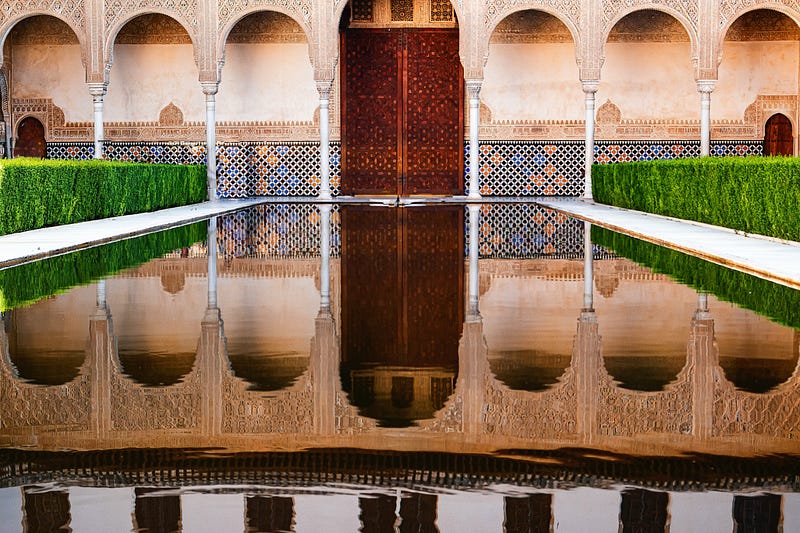
Granada — A City at the Cultural Crossroads
After a thorough tour of the Alhambra, it’s worth spending a little more time in the city of Granada itself, which has to offer not only extraordinary testimonies of history in the form of amazing architecture, but also a fantastic atmosphere of true Andalusia.
Nestled against the slopes of the Sierra Nevada, the city was a bastion of Moorish rule and the heart of the Arab state of Al-Andalus for over eight centuries. It was also here, shortly before Columbus set sail for India, that Islamic rule in Europe came to an end.
A symbol of later times is the imposing cathedral of Santa María de la Encarnación. Planned as a triumph for Queen Isabella the Catholic, it stands — like most Andalusian churches — on the foundations of a former mosque. The stone temple is surrounded by the chaos of an oriental bazaar. Dozens of stalls selling fabrics from Morocco, gold-embroidered shoes and rainbow-colored tea glasses make me move to the East in the blink of an eye.
Oriental touches, however, are best discovered on the other side of Gran Vía Avenue. The stone steps of the Calderería Nueva climb upwards. Because of the dozens of Arabic bars, the locals know this place as Calle de las Teterías, or the Street of Tea Houses. From the windows of the stores, mountains of pistachio sweets dripping with honey tempt you. For the tiny sesame bagels just taken out of the oven a queue immediately forms.
The Tea House Street is the gateway to the labyrinth of Albayzín, the Arab quarter. Through the windows in the wooden gates, I look at the lush thickets of cármenes — gardens surrounding wealthier Andalusian homes. Cobblestone streets avoid right angles, and again and again I enter squares decorated with fountains. On the white walls, I read the oriental-sounding street names inscribed on blue ceramic azulejos tiles. Centuries ago Albayzín was surrounded by a wall. Today only fragments remain.
Through the Arco de las Pesas, or Arch of Weights, we enter the picturesque square of Plaza Larga. A market is held there every morning, but in the afternoon, as soon as the stalls close, cafe life returns to the square. The patisserie on the corner has been selling the best miloja cake.
Grenada, a student city, is famous for its tradition of free tapas, or snacks served with drinks in virtually every bar. While in other cities tapas is a bowl of peanuts, in Granada for the price of a drink you can sample the best Andalusian flavors. Grilled eggplant with honey, sandwiches with spicy chorizo, triangles of potato tortilla are perfect accompaniments to strong local wine. The higher we climb through the backstreets of the white labyrinth, the more caves there are. Painted rock walls hide entrances to residential caves, popular for centuries in the highest part of town: the bohemian Sacromonte.
Since the beginning of the district’s existence, the poor inhabitants, due to lack of funds, drilled the surrounding slopes and inhabited the shelters thus created. Even today, rooms in caves do not surprise anyone, the caves of Sacromonte also hide the best tablaos in the city — flamenco bars. When we return to Albayzín late in the evening after a concert lasting several hours, the Mirador San Nicolás square with its magnificent view of the Alhambra is still full of people. Someone is playing the guitar, restaurant guests are sipping their drinks, everyone is sitting facing the illuminated walls of the thousand-year-old fortress. Alhambra — as I have already mentioned — means “red castle” in Arabic.
White towns of Andalusia
Ronda is one of dozens of Andalusian pueblos blancos, white towns whose history dates back to Arab times. 30 km to the west, from behind the green-brown hills another village emerges: Zahara de la Sierra. From afar it looks like a shiny spot above the mirror of the lake waters. The town seems to be glued to the rocks, and at the very top rise the 800-year-old ruins of a castle.

It seems that after visiting Ronda nothing will surprise me anymore, but when I finally stand on the tower, I can’t catch my breath, a little bit from fatigue, but mostly from admiration. White walls and red roofs, olive green hills, and at the bottom the waters of the lake are the extraordinary landscape of Andalusia, completely different from the noisy resorts of the coast. Finally, there is Córdoba. In the 11th century there were three thousand mosques here.
Today all attention is focused on the Mezquita, founded in the eighth century, one of the world’s most magnificent Islamic buildings. With its forest of columns, connected by striped, white and maroon arches, the Great Mosque never ceases to amaze. An unexpected addition is the Christian cathedral, a symbol of the Reconquista, built after the conquest of the city in the heart of the temple, but that doesn’t stop you from getting lost again and again among the rows of marble pillars. The zigzagging, narrow streets seem like a chaotic maze — but this layout makes it easier to find pleasant shade and coolness in the hot climate. Houses follow similar rules and almost everyone has a tiled patio, the larger ones with fountains and orange trees.
The inhabitants of Córdoba surpass themselves in decorating these backyards, which is especially evident in May. For a hundred years, then takes place a competition for the most beautiful patio in the city. Residents hang dozens of pots of vibrant red geraniums on the walls of their homes, refresh the blue colors of their shutters, and decorate the iron bars of their windows with garlands of flowers. Hundreds of courtyards open up to the public. The most popular are those around Calle de San Basilio. It smells of oranges when, out of the tangle of courtyards, I return under the honey-colored block of the Great Mosque. I climb the Roman bridge that has stood here for 2,000 years.
I could stay in Andalusia for a very long time and there would still be much to discover. But years of learning the mysteries of the Spanish South is actually a very tempting prospect.
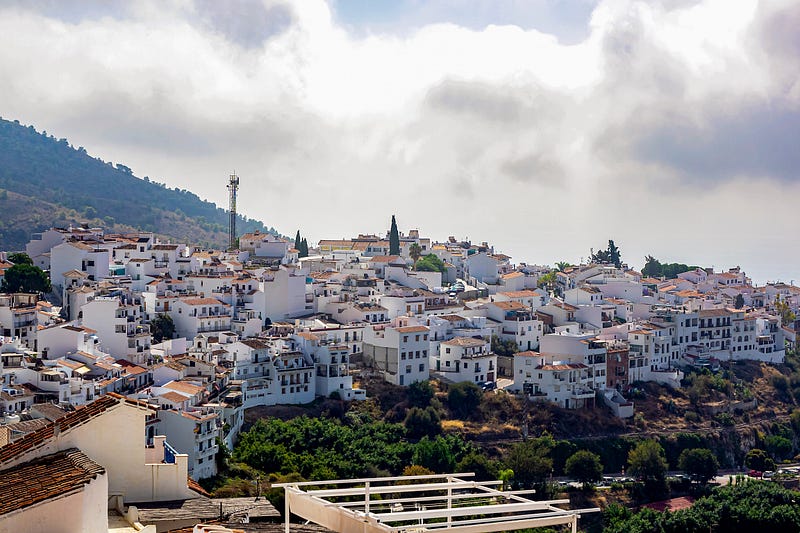
Andalusia — Practical Information
You can get to Malaga in southern Spain from Poland by plane. Direct connections are provided by WizzAir. For a return ticket you will have to pay about $250. During the holiday season you can also try to find charter flights provided by travel agencies.
You can easily get around Andalusia by car. Spain has a well-developed network of car rental companies and a very well developed system of roads and highways. Speed limit is 110 km / h.
Historic city centers are best traversed on foot. Given the irregular urban layout, narrow streets and limited parking spaces, it is recommended to use public transportation in the cities and leave cars in parking lots before entering the center. In Málaga and Seville, the metro is under construction.
Spain has one of the best developed rail networks in Europe. As editors of National-Geographic we recommend and encourage you to travel by this mode of transport. Rail is relatively inexpensive and much more environmentally friendly than cars. The Spanish National Railway Network (RENFE) offers a full range of services connecting the main cities of Andalusia and many smaller municipalities. Regional services (“Cercanías”) connect towns and villages and in the provinces of Málaga and Cadiz. With the AVE super-fast trains, you can get from Málaga to Córdoba, Seville and even Madrid expressly and conveniently. Special prices and discounts apply for students, groups, people over 60, round-trip tickets, etc.
As an alternative to flying, consider traveling to Spain by train. Although the trip will take about 30 hours and require several changes in different European cities, such a journey can be an unforgettable experience.
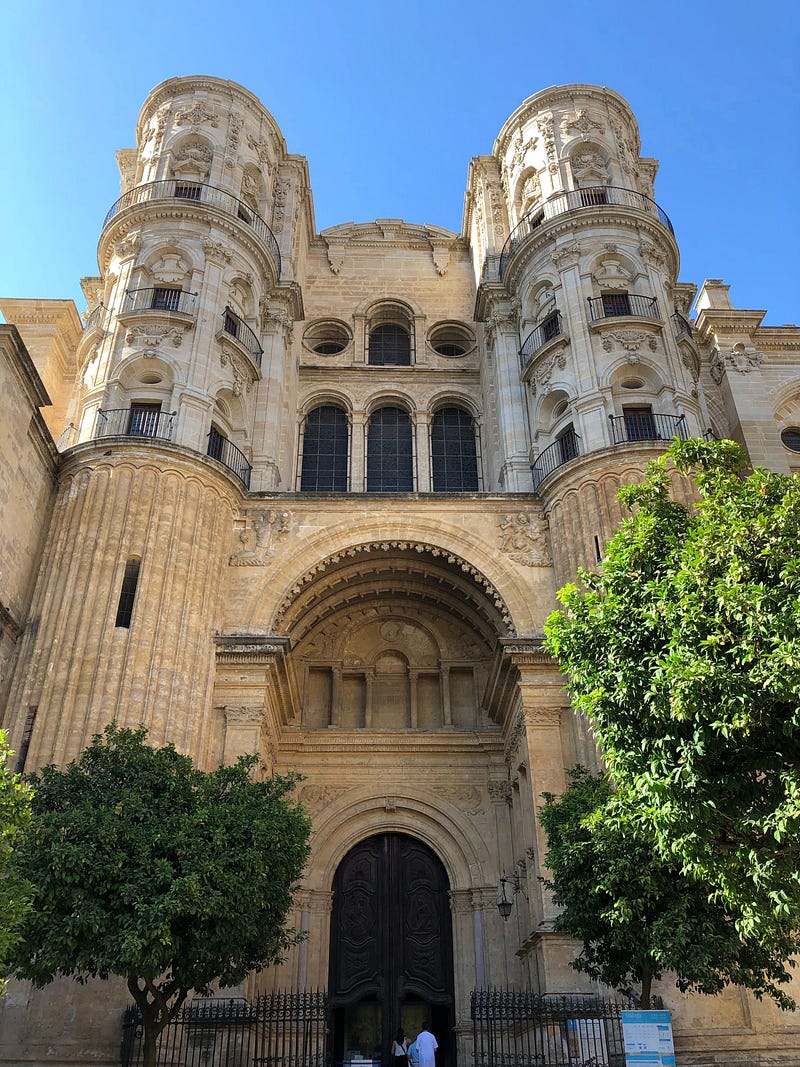
Alhambra — Tickets
From March to October the Alhambra is open from 8.30 a.m. to 8 p.m. In the other months until 6 p.m. From Tuesday to Saturday you can take a night tour (from 10 to 10.30 p.m.).
Guided tours (English, Spanish or French) for groups of up to 30 people last 2.5 hours. Prices start at €35 and include entrance fees to the Alhambra. A tour with a private guide costs 175 EUR.
There are 3 types of tickets to choose from:
- Day ticket
- Night ticket
- Generalife gardens ticket
The most popular day ticket costs 14,85 EUR. It is worth to buy tickets online. On site — especially during the tourist season — you can expect crowds of visitors.

When planning a trip to Andalusia, keep in mind that in summer there is a hot and dry climate. In July and August temperatures can exceed 40 degrees C. Although the small and narrow streets of towns and squares and parks provide shade and a bit of cooling, do not forget to bring a bottle of water and a hat.
Granada — What to eat
The cuisine of Andalusia draws on the rich traditions of the region. The oldest known cookbook with Andalusian recipes dates back to the 14th century. When visiting Granada, it is worth trying the local specialties:
- pescaito frito — fried fish,
- jamon iberico — Iberian ham
- wines from Jerez, especially sherry
- churros — Spanish deep-fried baked goods made of wheat flour
- plato Alpujarreño — grilled meats with eggs and potatoes
- gazpacho — Spanish-style cooler, especially great on hot days
- pipirrana — salad of tomatoes, green peppers, onions and cucumbers cut into small pieces and marinated with salt and olive oil.
- arab sweets — the heritage of the Muslim history of the city. These pastries are usually made of puff pastry with nuts and honey. To be tasted in many cafes in Grenada.
Cool that you made it to the end of this article. I will be very pleased if you appreciate the effort of creating it and leave some claps here, or maybe even start following me. Thank you!
